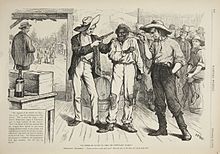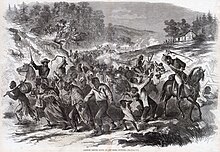James W. Loewen
Appearance
James W. "Jim" Loewen (February 6, 1942 – August 19, 2021) was an American sociologist, historian, and author.
Quotes
[edit]




1990s
[edit]1999
[edit]Lies Across America: What American Historic Sites Get Wrong (1999)
[edit]- Between 1890 and about 1970, northerners found it less embarrassing to let Dixie tell the story of the cause it lost than to reminisce about the cause they had abandoned. The Civil War had been about something other than states' rights after all. It began as a war to force or prevent the breakup of the United States. As it ground on it became a struggle to end slavery. At Gettysburg in the fall of 1863, Abraham Lincoln was already proclaiming 'a new birth of freedom', black freedom. Conversely, on their way to and from Gettysburg, Lee's troops seized scores of free black people in Maryland and Pennsylvania and sent them south into slavery. This was in keeping with Confederate national policy, which virtually re-enslaved free people of color into work gangs on earthworks throughout the south.
- p. 350
2000s
[edit]2007
[edit]Lies My Teacher Told Me: Everything Your American History Textbook Got Wrong (1995, 2007)
[edit]- Lies My Teacher Told Me: Everything Your American History Textbook Got Wrong (2007), New York: New Press
- Those who don't remember the past are condemned to repeat the eleventh grade.
- p. 1
- During the civil war, northern Democrats countered the Republican charge that they favored rebellion by profession to be the 'white man's party.' They protested the government's emancipation of slaves in the District of Columbia and its diplomatic recognition of Haiti. They claimed Republicans had nothing but 'nigger on the brain.' They were enraged when the U.S. Army accepted African American recruits; and they made race a paramount factor in their campaigns. In those days before television, parties held coordinated rallies. On the last Sunday before the election, Democratic senators might address crowds in each major city. Local officeholders would hold forth in smaller towns. Each of these rallies featured music. Hundreds of thousands of songbooks were printed so the party faithful might sing the same songs coast to coast. A favorite in 1864 was sung to the tune of 'Yankee Doodle Dandy'. The new national anthem, 'Nigger Doodle Dandy.'
- As quoted in Lies My Teacher Told Me: Everything Your American History Textbook Got Wrong (2007), New York: New Press, pp. 191–192
- Textbooks. . . keep students in the dark about the nature of history. History is a furious debate informed by evidence and reason. Textbooks encourage students to believe that history is facts to be learned [and] because textbooks employ such a godlike tone, it never occurs to most students [or teachers] to question them.
- Songs such as 'Nigger Doodle Dandy' reflect the racist tone of the Democrats' presidential campaign in 1864. How did Republicans counter? In part, they sought white votes by being anti-racist. The Republican campaign, boosted by military victories in the fall of 1864, proved effective. The Democrats' overt appeals to racism failed, and anti-racist Republicans triumphed almost everywhere. One New York Republican wrote 'The change of opinion on this slavery question ... is a great and historic fact. Who could have predicted ... this great and blessed revolution?' People around the world supported the Union because of its ideology.
- As quoted in Lies My Teacher Told Me: Everything Your American History Textbook Got Wrong (2007), New York: New Press, p. 192
- If knowledge is power, ignorance cannot be bliss.
- As quoted in Lies My Teacher Told Me: Everything Your American History Textbook Got Wrong (2007), New York: New Press, p. 342
- Emotion is the glue that causes history to stick.
- As quoted in Lies My Teacher Told Me: Everything Your American History Textbook Got Wrong (2007), New York: New Press, p. 342
- Ideas made the opposite impact in the Confederacy. Ideological contradictions afflicted the slave system even before the war began. John Brown knew the masters secretly feared their slaves might revolt, even as they assured abolitionists that slaves really liked slavery. One reason his Harpers Ferry raid prompted such an outcry in the South was that slave owners feared their slaves might join him. Yet their condemnations of Brown and the 'Black Republicans' who financed him did not persuade Northern moderates but only pushed them toward the abolitionist camp. After all, if Brown was truly dangerous, as slave owners claimed, then slavery was truly unjust. Happy slaves would never revolt... White Southerners founded the Confederacy on the ideology of white supremacy. Confederate soldiers on their way to Antietam and Gettysburg, their two main forays into Union states, put this ideology into practice: they seized scores of free black people in Maryland and Pennsylvania and sold them south into slavery. Confederates maltreated black Union troops when they captured them.
- As quoted in Lies My Teacher Told Me: Everything Your American History Textbook Got Wrong (2008), p. 193
- According to Confederate ideology, blacks liked slavery; nevertheless, to avert revolts and runaways, the Confederate states passed the 'twenty nigger law', exempting from military conscription one white man as overseer for every twenty slaves. Throughout the war, Confederates withheld as much as a third of their fighting forces from the front lines and scattered them throughout areas with large slave populations to prevent slave uprisings. When the United States allowed African Americans to enlist, Confederates were forced by their ideology to assert that it would not work; blacks would hardly fight like white men. The undeniable bravery of the 54th Massachusetts and other black regiments disproved the idea of black inferiority. Then came the incongruity of truly beastly behavior by southern whites towards captured black soldiers, such as the infamous Fort Pillow massacre by troops under Nathan Bedford Forrest, who crucified black prisoners on tent frames and then burned them alive, all in the name of preserving white civilization.
- As quoted in Lies My Teacher Told Me: Everything Your American History Textbook Got Wrong (2007), New York: New Press, pp. 224–225
- Some Confederate soldiers switched sides, beginning as early as 1862. When Sherman made his famous march to the sea from Atlanta to Savannah, his army actually grew in number, because thousands of white southerners volunteered along the way. Meanwhile, almost two-thirds of the Confederate army disappeared through desertion. Eighteen thousand slaves joined Sherman, so many that the army had to turn some away. Compare these facts with the portrait common in our textbooks of Sherman's marauders looting their way through a united south. The increasing ideological confusion in the Confederate states, coupled with the increasing strength of the United States, helps explains the Union victory... Many nations and people have continued to fight with far inferior means and weapons... The Confederacy's ideological contradictions were its gravest liabilities, ultimately causing its defeat.
- As quoted in Lies My Teacher Told Me: Everything Your American History Textbook Got Wrong (2007), New York: New Press, pp. 225–226
2010s
[edit]- In the twentieth century no one's hands were clean. Korean troops committed more atrocities per capita than Americans, in Vietnam. Vietnam of course attacked Cambodia. Japan attacked almost everyone. And so on.
2011
[edit]- Americans, 150 years after the Civil War began, are still getting it wrong.
2014
[edit]How Two Historians Responded To Racism In Mississippi (December 2014)
[edit]- Full text of "How Two Historians Responded To Racism In Mississippi" (7 December 2014), History News Network
- In the nineteenth century, the Democratic Party was the party of overt white supremacy and even called itself 'The White Man's Party' into the 1920s.
- White Democrats opposed Reconstruction not because it was a failure, but because it was working. Today almost all historians of Reconstruction hold that view.
2015
[edit]- It's one thing to remember history and to put up historical markers that get it right. It's quite another thing to commemorate someone and to name stuff for him. You don't learn anything from driving the Jefferson Davis Highway about Jefferson Davis except that he was a great man and should be honored. And it's precisely that last little bit - should be honored - that we need to take away from him.
- As quoted in "Rejection Of Flag Exposes Larger Truths About The Confederacy" (2 July 2015), by Robert Siegel, NPR
Why do people believe myths about the Confederacy? Because our textbooks and monuments are wrong (2015)
[edit]- "Why do people believe myths about the Confederacy? Because our textbooks and monuments are wrong. False history marginalizes African Americans and makes us all dumber." (1 July 2015), The Washington Post
- Take Kentucky. Kentucky's legislature voted not to secede, and early in the war, Confederate Gen. Albert Sidney Johnston ventured through the western part of the state and found 'no enthusiasm as we imagined and hoped but hostility … in Kentucky.' Eventually, 90,000 Kentuckians would fight for the United States, while 35,000 fought for the Confederate States. Nevertheless, according to historian Thomas Clark, the state now has 72 Confederate monuments and only two Union ones.
- Neo-Confederates also won western Maryland. In 1913, the United Daughters of the Confederacy (UDC) put a soldier on a pedestal at the Rockville courthouse. Montgomery County never seceded, of course. While Maryland did send 24,000 men to the Confederate armed forces, it sent 63,000 to the U.S. Army and Navy. Nevertheless, the UDC's monument tells visitors to take the other side: 'To our heroes of Montgomery Co. Maryland / That we through life may not forget to love the Thin Gray Line'. In fact, the Thin Grey Line came through Montgomery and adjoining Frederick counties at least three times, en route to Antietam, Gettysburg and Washington. Lee's army expected to find recruits and help with food, clothing and information. They didn't. Maryland residents greeted Union soldiers as liberators when they came through on the way to Antietam. Recognizing the residents of Frederick as hostile, Confederate cavalry leader Jubal Early demanded and got $300,000 from them lest he burn their town, a sum equal to at least $5,000,000 today. Today, however, Frederick boasts what it calls the 'Maryland Confederate Memorial', and the manager of the Frederick cemetery — filled with Union and Confederate dead — told me in an interview, “Very little is done on the Union side” around Memorial Day. “It’s mostly Confederate.”
What Does Rockville, Maryland's Confederate Monument Tell Us About the Civil War? About the Nadir? About the Present? (July 2015)
[edit]- "What Does Rockville, Maryland's Confederate Monument Tell Us About the Civil War? About the Nadir? About the Present?" (19 July 2015), History News Network
- 'The Thin Grey Line' came through Montgomery and Frederick counties at least three times, en route to Antietam in 1862, Gettysburg in 1863, and Washington in 1864. Lee's army expected to find recruits and help with food, clothing, and information. This did not happen, although the army did kidnap every African American it came upon, dragging them back into Virginia as slaves. In a further irony, on the courthouse grounds not far from the Confederate monument, a historical marker tells of J.E.B. Stuart's 1863 raid nearby, in which he captured 'as many as a hundred' African Americans and enslaved them, but they are invisible. The marker only mentions the capture of '150 U.S. wagons'. During the first invasion, Maryland residents greeted Union soldiers 'as liberators' when they came through on their way to Antietam, according to historian William F. Howard. During the last invasion, when Confederate cavalry leader Jubal Early came through, he demanded and got $300,000 from the leading merchants of Frederick, lest he burn their town, a sum equal to at least five million dollars today.

